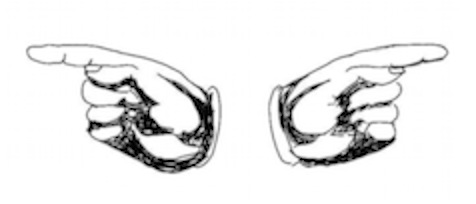I’ve been known to joke and tease at wedding rehearsals about grooms having trouble telling the difference between their left and right hands. When giving instructions for the exchange of rings, I demonstrate to couples how I will hand the rings to them so that they are not dropped and I will often comment that the bride will naturally offer the correct finger so the groom doesn’t have to worry about whether or not it is the right hand or the correct finger. The groom, on the other hand, doesn’t have the advantage that I have. I have a wedding ring on my left hand, so it is easy to tell left from right by looking at my own hands. So I assure the couple that if the ring were to go on the wrong finger, the marriage would still be accomplished and there is no point in worrying about it. The jokes are part of easing tension so that the couple is freed to celebrate their wedding without fear.
But I sometimes encounter people who don’t seem to know their left from their right.
It can be confusion if you forget that left and right are terms that require a certain amount of perspective. If I am facing you and I point to my left, I will be pointing to your right. Preachers and actors and others who address audiences learn to compensate for this simple reality. When we print litanies with parts for the left and right hand sides of the congregation, for example, we make sure that it is clear that right refers to the right of congregation members as they sit in the pews and face the chancel. Liturgists are instructed to indicate the right and left sides of the congregation by pointing to the appropriate side from the perspective of the congregation, not from their own perspective as they face the crowd.
In theatre, the terms “stage right,” “stage left,” “audience right,” and “audience left” are used to avoid the confusion. It is a bit different with a boat. Port is the left side of the boat when facing the direction of travel. Starboard is the right, again from the position of facing the direction of travel. It doesn’t matter which direction a person is facing while riding on the boat, the port and the starboard of the ship remain constant. If you are facing the rear of the ship, the starboard is your left and the port is your right. I might sound confusing in theory, but it is very clear when giving and receiving commands to operate a sailboat or other craft.

Years ago, when I was directing an Exodus Water Sports camp in Idaho, we took our campers on a short relatively flat water stretch of the Payette river near Payette Lake. Due to changing water levels, we arranged to have the river scouted a few days before the start of the camp. A couple of counselors ran the stretch of river in inflatable rafts to check things out ahead of taking the canoes and campers to the put-in site. I did some scouting of the transport routes and wasn’t on the river that day. The next week during camp, I lead my group of campers down the river. At one point, we took the wrong fork and ended up needing to walk the canoes over a short section of water too shallow to float the boats with campers in them. Then we had to make a short portage over a short spit of land before putting the canoes and campers back in the water. The process left campers muddy and mosquito bitten. That evening, as our staff debriefed the day, I reviewed the route we took. The counselor who had scouted the river, chided me saying, “That place where you took the right fork – you were supposed to take the other right!” We all laughed and the expression “the other right” became a way of urging one another to consider different options when we seemed to have set course in the wrong direction. It was all in good humor and to this day when I encounter someone who had worked on those camps we’ll use the term “the other right” to refer to our left.

The thing that has been the current source of distraction for me lately has been the reaction of drivers when approaching open intersections. Due to some construction, I have been taking a variety of different routes to the church, driving through a residential neighborhood with plenty of unmarked intersections. The law is very clear on which car has the right of way when two approach an intersection simultaneously. You are directed to yield to the car on your right. The term “right of way” has a connection to which car should go first. It may have some historic connection to which side of the road a car is to operate on and the protection of passengers, since drivers sit in the left side of the car nearest the centerline. Regardless of the origins of the law, the rules of the road are clear. But I frequently encounter people who seem to have no clue what to do when they approach the intersection at the same time as I. They stop their car just short of the intersection look at me and wave their hands as if to say, “you go first.” I try to observe the right of way rules, but after a few moments it gets ridiculous trying to get the other driver to take the right of way, with them waving me on through the intersection. Frequently, when I start out, they do so at the same time, scaring us both. It would be so much easier if rather than “you go first” being considered to be good manners, for it to be considered bad form to encourage another driver to violate the right of way rules. The rules were, of course, made for the situation. It is only a minor inconvenience, however, and I usually have the patience to out wait those who are waving their arms. Sometimes I hold up my hands and point while mouthing the words “left” and “right” as I wait for them to go through the intersection.
Another place where people seem to forget directions is in parking lots. I don’t know how many times I have encountered other drivers who insist on passing my car on the wrong side when driving through a parking lot. What seems to be obvious to me seems to elude the drivers of the other vehicles.
Then, again, perhaps those vehicles are being driven by unmarried men who, without wedding rings, have no way of knowing their right from their left.
Perhaps they ought to spend some time driving in England or Australia.
Copyright © 2013 by Ted Huffman. I wrote this. If you want to copy it, please ask for permission. There is a contact me button at the bottom of this page. If you want to share my blog a friend, please direct your friend to my web site.


